#serapis deity
Explore tagged Tumblr posts
Text


it is spring, and Serapis is here/alive/reborn
11 notes
·
View notes
Text
If Plouton is the better version, then Sarapis, who's photo come out first on Hades' wiki page, is the best version. As the master of universe, king of dead, god of healing and other useful power, Sarapis is often seen alongside a three-headed dog and wear a cool crown.
He remains devoted to his wife and has never been involved in any kidnapping drama. One of my favorite images of Sarapis shows him and Isis deeply immersed in a kiss.(x) The only "issue" is that he and Isis might be siblings. Osiris is well-known to be Isis's brother, but the details regarding Sarapis are rather vague. (Maybe I just missed it, I can't remember any sources about it.)

The other one of my favorite(X), Helios embrace Sarapis and kiss him passionately,while Sarapis seems quite nervous.🤣 An interesting related story is as below:
There was a tiny window so orientated toward the direction of sunrise that on the day appointed for the statue of the sun to be carried in to greet Serapis, careful observation of the seasons had ensured that as the statue was entering, a ray of sunlight coming through this window would light up the mouth and lips of Serapis, so that to the people looking on it would seem as though the sun was greeting Serapis with a kiss.(X)

Many Greek/Roman authors identify Sarapis with Plouton or Hades, but also Zeus, Dionysus, Asclepius and others. I am not suggesting that image of Sarapis should not be called Hades, but it's important to recognize both their similarities and differences.



#he is underrated and ignored in retelling#not a bad thing#sincere suggestion: Some of our beloved modern H×P fans should consider shipping S×I instead and keep away from the Greek chthonic couple:)#greek religion#roman religion#sarapis#serapis#sarapis deity#serapis deity#isis deity#helios#helios deity#plouton#hades deity#egypt#egyptian deities#ancient rome#hellenic polytheism#hellenism#hellenic deities#greek mythology
0 notes
Text
🏺THE MYSTERIES OF ISIS: SYNCRETISM IN ANCIENT ROME PT.2🏺


Left: Priestess of Isis,John Cheere (18th century), National Trust Collection. Right: Priestess of isis, Museo Archaeologico Regionale, Palermo, Sicily.
As we've seen in the previous post, foreign gods made their way into Roman culture. In the case of Egyptian gods, they were usually adopted by the Greeks before arriving to the Italic peninsula.
In this post, we're going to talk about the mysteries of Isis. Unlike typical religious practices, which were often public services, mystery rites promised their followers a closer connection to a particular god.
Isis wasn't the only nor the first god to have a mystery rite. In fact, it surged as a way to honour the foreign godess in a somewhat "familiar" way.
The Eleusinian (honouring Demeter and Persephone, also known as Kore) and the Orphic mysteries (Orpheus) had an earlier development in Greek culture and would become the most famous mystery rites.

Wall painting depicting Isiac rites.
The practices of the cult was, as the name suggests, a mystery. Participants had to swear a vow of secrecy, and, as a consequence of its private character, many things are unknown to us.
The rites heavily focused on death and belief on the afterlife, and also recreated the myths surrounding the godess Isis, like the murder of Osiris.
One of the only accounts of the mysteries of Isis is depicted in The Golden Ass. In Book 11, Lucius, the protagonist, is transformed back into a human guided by the Egyptian goddess. In return, Lucius becomes part of the cult.
As other pagan cults and worships, the mystery rites died out when Christianity rose to power.
#pagan polytheism#ancient history#art history#hellenic deities#hellenism#ancient rome#ancient egypt#serapis#isis goddess#hellenic pagan#hellenic paganism#cultus deorum#eleusinian mysteries#orphic#orphic mysteries#pagan worship
41 notes
·
View notes
Text
Shout out to the lesser known syncretic deities of the hellenistic period, I love y'all:
Serapis (who seems to have been syncretized with Hades/Pluto), lord of the Underworld who arose from Osiris-Apis



Harpocrates, child god of silence, son of Isis and Serapis who arose from the child Horus



Hermanubis, who arose out of the syncretism of Hermes and Anubis


Zeus/Jupiter Ammon, from the syncretism of Zeus and Ammon

Isis in her greco-roman interpretation, wife of Serapis and mother of Harpocrates, commonly shown breastfeeding him. She was syncretized with Aphrodite, Demeter and Persephone

I may make another post like this later
#hellenic pagan#hellenic polytheism#hellenic paganism#hellenic polythiest#hellenic deities#hellenistic deities#hellenistic#helpol#serapis#isis#harpocrates#zeus ammon#hermanubis
9 notes
·
View notes
Text
At Pompeii, Isis clearly is represented as the more prominent divinity. Possibly the major cult statues were of Isis and Serapis, but of these, only the head belonging to what may be the cult statue of Isis has survived. One can easily find Isis in the temple. Along the prominent arched wall of the west portico on the extreme left, we find a statue of Aphrodite Anadyomene. The statue evidently represents the interpretatio graeca of Isis, whereas Isis with the ankh on the extreme right seems to be an archaizing Hellenistic form of the goddess.
Mystery Cults in the Ancient World by Hugh Bowden
#op#helpol#hellenic polytheism#egyptian polytheism#rompol#roman polytheism#syncretism#isis#isis deity#aphrodite#aphrodite deity#serapis#He's in here too!#egypol#magna graecia#pompeii#campania
4 notes
·
View notes
Text

Statuette (copper alloy) of the composite Greco-Egyptian deity Serapis Amun Agathodaimon.
1st cent. BCE/CE (late Hellenistic or early Imperial).
From Egypt; now in the National Archaeological Museum, Athens, Greece.
796 notes
·
View notes
Text

More than 200 Survivors of Mount Vesuvius Eruption Discovered in Ancient Roman Records
After Mount Vesuvius erupted, survivors from the Roman cities of Pompeii and Herculaneum fled, starting new lives elsewhere.
On Aug. 24, in A.D. 79, Mount Vesuvius erupted, shooting over 3 cubic miles of debris up to 20 miles (32.1 kilometers) in the air. As the ash and rock fell to Earth, it buried the ancient cities of Pompeii and Herculaneum.
According to most modern accounts, the story pretty much ends there: Both cities were wiped out, their people frozen in time.
It only picks up with the rediscovery of the cities and the excavations that started in earnest in the 1740s.
But recent research has shifted the narrative. The story of the eruption of Mount Vesuvius is no longer one about annihilation; it also includes the stories of those who survived the eruption and went on to rebuild their lives.
The search for survivors and their stories has dominated the past decade of my archaeological fieldwork, as I’ve tried to figure out who might have escaped the eruption. Some of my findings are featured in an episode of the new PBS documentary, “Pompeii: The New Dig.”
Making it out alive:
Pompeii and Herculaneum were two wealthy cities on the coast of Italy just south of Naples. Pompeii was a community of about 30,000 people that hosted thriving industry and active political and financial networks. Herculaneum, with a population of about 5,000, had an active fishing fleet and a number of marble workshops. Both economies supported the villas of wealthy Romans in the surrounding countryside.
In popular culture, the eruption is usually depicted as an apocalyptic event with no survivors: In episodes of the TV series “Doctor Who” and “Loki,” everyone in Pompeii and Herculaneum dies.
But the evidence that people could have escaped was always there.
The eruption itself continued for over 18 hours. The human remains found in each city account for only a fraction of their populations, and many objects you might have expected to have remained and be preserved in ash are missing: Carts and horses are gone from stables, ships missing from docks, and strongboxes cleaned out of money and jewelry.
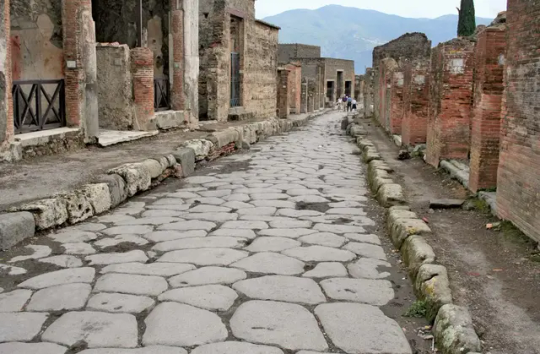
All of this suggests that many – if not most – of the people in the cities could have escaped if they fled early enough.
Some archaeologists have always assumed that some people escaped. But searching for them has never been a priority.
So I created a methodology to determine if survivors could be found. I took Roman names unique to Pompeii or Herculaneum – such as Numerius Popidius and Aulus Umbricius – and searched for people with those names who lived in surrounding communities in the period after the eruption. I also looked for additional evidence, such as improved infrastructure in neighboring communities to accommodate migrants.
After eight years of scouring databases of tens of thousands of Roman inscriptions on places ranging from walls to tombstones, I found evidence of over 200 survivors in 12 cities. These municipalities are primarily in the general area of Pompeii. But they tended to be north of Mount Vesuvius, outside the zone of the greatest destruction.
It seems as though most survivors stayed as close as they could to Pompeii. They preferred to settle with other survivors, and they relied on social and economic networks from their original cities as they resettled.
Some migrants prosper:
Some of the families that escaped apparently went on to thrive in their new communities.
The Caltilius family resettled in Ostia – what was then a major port city to the north of Pompeii, 18 miles from Rome. There, they founded a temple to the Egyptian deity Serapis. Serapis, who wore a basket of grain on his head to symbolize the bounty of the earth, was popular in harbor cities like Ostia dominated by the grain trade. Those cities also built a grand, expensive tomb complex decorated with inscriptions and large portraits of family members.
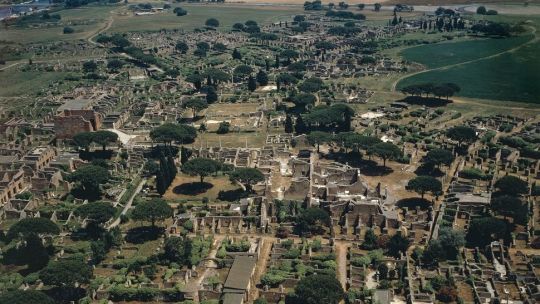
Members of the Caltilius family married into another family of escapees, the Munatiuses. Together, they created a wealthy, successful extended family.
The second-busiest port city in Roman Italy, Puteoli – what’s known as Pozzuoli today – also welcomed survivors from Pompeii. The family of Aulus Umbricius, who was a merchant of garum, a popular fermented fish sauce, resettled there. After reviving the family garum business, Aulus and his wife named their first child born in their adopted city Puteolanus, or “the Puteolanean.”
Others fall on hard times:
Not all the survivors of the eruption were wealthy or went on to find success in their new communities. Some had already been poor to begin with. Others seemed to have lost their family fortunes, perhaps in the eruption itself.
Fabia Secundina from Pompeii – apparently named for her grandfather, a wealthy wine merchant – also ended up in Puteoli. There, she married a gladiator, Aquarius the retiarius, who died at the age of 25, leaving her in dire financial straits.

Three other very poor families from Pompeii – the Avianii, Atilii and Masuri families – survived and settled in a small, poorer community called Nuceria, which goes by Nocera today and is about 10 miles (16.1 kilometers) east of Pompeii.
According to a tombstone that still exists, the Masuri family took in a boy named Avianius Felicio as a foster son. Notably, in the 160 years of Roman Pompeii, there was no evidence of any foster children, and extended families usually took in orphaned children. For this reason, it’s likely that Felicio didn’t have any surviving family members.
This small example illustrates the larger pattern of the generosity of migrants – even impoverished ones – toward other survivors and their new communities. They didn’t just take care of each other; they also donated to the religious and civic institutions of their new homes.
For example, the Vibidia family had lived in Herculaneum. Before it was destroyed by the eruption of Vesuvius, they had given lavishly to help fund various institutions, including a new temple of Venus, the Roman goddess of love, beauty and fertility.
One female family member who survived the eruption appears to have continued the family’s tradition: Once settled in her new community, Beneventum, she donated a very small, poorly made altar to Venus on public land given by the local city council.
How would survivors be treated today?
While the survivors resettled and built lives in their new communities, government played a role as well.
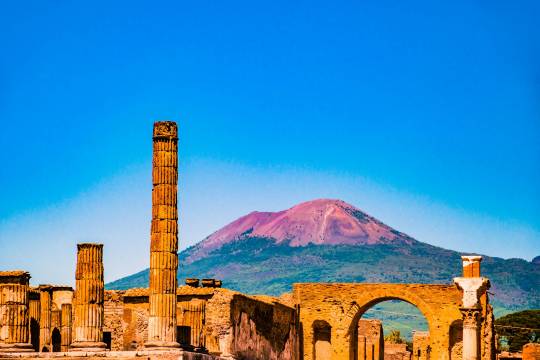
The emperors in Rome invested heavily in the region, rebuilding properties damaged by the eruption and building new infrastructure for displaced populations, including roads, water systems, amphitheaters and temples.
This model for post-disaster recovery can be a lesson for today. The costs of funding the recovery never seems to have been debated. Survivors were not isolated into camps, nor were they forced to live indefinitely in tent cities. There’s no evidence that they encountered discrimination in their new communities.
Instead, all signs indicate that communities welcomed the survivors. Many of them went on to open their own businesses and hold positions in local governments. And the government responded by ensuring that the new populations and their communities had the resources and infrastructure to rebuild their lives.
By Steven L. Tuck.

#More than 200 Survivors of Mount Vesuvius Eruption Discovered in Ancient Roman Records#Pompeii#Herculaneum#Mount Vesuvius#ancient artifacts#archeology#archeolgst#history#history news#ancient history#ancient culture#ancient civilizations#roman history#roman empire#long post#long reads
57 notes
·
View notes
Note
i just watched someone saying "christianity is and always will be the cultural appropriation of religions" and they mentioned the resurrection, which surprises me a little. do you know what they could be referring to? they also called it a very common trope and i'm no theologian, don't know that much about other religions or mythology, so maybe you could help?
resurrection narratives are absolutely not unique to christianity. there are resurrection narratives in the religion of ancient egypt (osiris), greece (adonis, zagreus, dionysus, and attus), and sumer (dumuzid and inanna). all of these predate christianity by centuries. to consider resurrection myths appropriation is, however, rather ignorant: the mythologies of the ancient near east are absolutely woven together, to the point where they are almost indistinguishable from each other, especially in the early history of the hebrews. the roman empire was heavily influenced by hellenic culture, religion, and philosophy. consider dionysus, the god of wine: plutarch stated that the stories of osiris and dionysus were identical and that the secret rituals asociated with them were obviously paralleled: the second century AD saw the emergence of greco-egyptian pantheons where the god serapis was synonymous with osiris, hades, and dionysus. this is also similar to the interrelationship between inanna, ishtar, asherah, astarte, and multiple other near eastern female deities (and she likely played an influence in the development of lilith as well). how much did the cult of dionysus influence later rites of the wine and the eucharist in early christianity, especially given that within fifty years of christ's death most christians were greeks? romulus and remus were said to have been born to a virgin, and so was the founder of zoroastrianism, zoroaster, a religion that influenced platonic philosophy and all abrahamic faiths.
christianity is more guilty of appropriation that most other faith practices of appropriation because of the crudeness and hatefulness with which it borrowed judaism and then turned on the jews. but attempting to divide western and near eastern religious traditions into pure (original) and impure (appropriated) is next to impossible. otherwise we can start trying to particularize everything as either pure or impure and discard what we deem as "impure" or unoriginal because we think it is valueless, hackneyed, or unethical. religion does not work like that. christianity does require critical consumption and practice because it has both appropriated judaism and because the way in which it exerted itself as a dominant religion over other faith practices. and the appropriation of judaism must be especially viewed as troubling, because judaism cannot be compared, historically, to religions like those of ancient egypt and greece because until the state of israel it was never a dominant or state religion, and the fact that it survived some odd thousand years without being recognized as a state religion is part of why it's particularly interesting. of course, that has changed now, but this ask isn't about israel/palestine and i won't dwell on it this issue much except to reaffirm that christianity appropriating an oppressed minority religion that emerged out of colonial contexts is very different than christianity utilizing aspects of ancient greek religion or zoroastrianism, and also different from jesus being included in islam, for instance.
interestingly, quetzalcoatl, from the ancient aztec religion, was the patron of priests and a symbol of resurrection. this gestures to the hidden sacred, eliade's hierophany: the hidden holiness, the sacrality and beingness of something beyond ourselves, that underlies all existence, with its own explicit truths that emerge consistently in faith practices that, unlike those of the near east, never interacted. maybe we all carried the same stories out of the cradle of civilization; maybe there is a perpetual and accessible truth that transcends boundaries. i don't know. but everything is borrowed. everything is copy. humanity is not capable of true originality: and isn't that beautiful? everything is taken in communion. everyone is interconnected. everyone wants to believe something, and we seem to be universally compelled by the same truths, motifs, meanings, and stories.
73 notes
·
View notes
Text
Demon or Deity? Deciphering Spirits
How to Confirm That You’re Talking to a God or Goddess
You can thank St. Augustine of Hippo for this. In the early 5th century, he wrote a theological essay against Paganism titled, “On the Divination of Demons.”
St. Augustine’s mother was Christian, and his father was Pagan. He understood both sides. He wrote many philosophical arguments for Christianity, his largest being The City of God.
In "On the Divination of Demons," Augustine fought back against an Oracle predicting the invasion of Serapis's temple. He argued that demons spoke to this Oracle. He argued that All Pagan Gods are Demons in disguise. He ridiculed fortune tellers and future predictions comparing them to the circus.
Do the arguments hold some sort of validity?
While Spirits can impersonate Deities this guy can now be pushed away from the conversation.
I’ll ask that question again.
Can Spirits Impersonate Deities?
The short answer is Yes.
The long answer depends on your experience level and knowledge.
If you are not used to the deity’s signs and how they communicate or you do not know which red flags to look out for, you are prone to deceit.
Red Flags
Messages drastically change.
For example, recently you received a sign from the Goddess Hekate. She wants to work with you.
The next week, another message tells you that She does not like you. Deities rarely change their mind without good reason. Double-check the divination.
People do everything for you.
Deities do not need to go through others to speak to you. Even if you cannot hear Them directly, deities can contact you in different ways. If someone else does a reading that sounds completely different, question it. Especially if it’s random and not requested. Do not use other people to translate things for you all the time. Spiritual journeys are personal. They are meant for you, and a lot of people get hurt this way. Other individuals love taking advantage of people using them for their own motives. Just be careful out there.
Overly negative or apocalyptic.
I've heard an unfortunate amount of people claim that the world was going to end after contacting their spirits. Why would they let go of any worshippers telling them that? Why would they give someone a sense that they are the chosen one? Question that. No one is special. We are all here for the human experience. Try dealing with that first even if you don’t want to.
The entity is trying to force you into things.
You do not need to answer spirits. A deity could ask you to worship Them. You can also say no. With years of experience, I have never heard of a deity punishing someone for not working with Them. If a message sounds like a threat, then question everything, and it’s probably best to ignore it.
How to Guarantee That You’re Speaking to a Deity
Ask the same question several times.
Use your preferred divination technique writing down all the answers to your questions. After one day has passed, repeat the same method rephrasing the questions asking the spirit again. Sometimes there are inconsistencies. Question what feels right and what does not.
Thoughts belong to whom?
Are the thoughts yours or are the thoughts external from you? Sometimes strong emotions are mistaken for spiritual signs. It’s easy to get caught up in your own head and let it take over hijacking the metaphysical exercise. Always question this. Did you anticipate a specific answer? This can also lead to derailment. It doesn’t hurt to ask again to gain confirmation. Before contacting your deity, stabilize your emotional state.
Gathering valuable resources.
Contrary to what I just said you can seek outside opinions for valuable resources. Become familiar with the deity’s information beforehand and ask about other peoples’ experiences. Just don’t let people take over the work or tell you how to think. Try to do the work yourself. Research is key.
Different techniques for you.
Try a different form of divination to see if the answers are around the same or greatly vary. This won’t hurt and it will help you learn more. Trust your instincts in spirit work. It’s okay to question things.
Protection orders.
If there is constant anxiety and worry, then do yourself the favor and put-up protection wards before spiritual communications begin. It will give you some peace of mind and it doesn’t hurt anything at all.
#energy work#energy manipulation#witch#pagan#witch tips#witchblr#witchcraft#pagan witch#spirit work#witch community#beginner witch#baby witch#metaphysics#metaphysical#witch stuff#witches#witches of tumblr#pagan blog#paganblr#pagans of tumblr#paganism#divination#spiritualism#spirituality#spiritual#spiritualgrowth#spiritual disciplines#spirits#deity#deity work
87 notes
·
View notes
Text
Isis Deity Deep Dive
Known most notably as the “mother goddess”, Isis comes with many names, many stories, and many talents. Let’s get to know her!

Parents and Siblings
Geb and Nut
Osiris (brother)
Set (brother)
Nephthys (sister)
Horus the Elder (brother)
Lovers or Partners
Osiris is most commonly noted as her husband
Min
Serapis
Horus the Elder
Children
Horus (the younger)
Min
Four Sons of Horus
Bastet (sometimes)
Isis had many names (see image for her name in Hieroglyphs), often these doubled as titles that described her role.
The Divine One
The Queen of all Gods
Queen of Heaven
The Maker of Sunrise
Mother of God
Khut: giver of light at the beginning of a new year
Usert: goddess of the earth
Thenenet: goddess of the Tuat (the underworld)
Satis: the Nile flood’s power
Ankhet: providing fertility from the waters and embracer of the land
Kekhet: goddess of the fields and the cultivated areas
Renenet: goddess of the harvest
Tcheft: goddess of the food offered to the gods by humans
Ament: lady of the underworld who restored the bodies of the dead so they could live with Osiris in his kingdom.
Notes
Other names given to the goddess are Aset, Aust, Eenohebis, Eset, Esu, Hesat, Iahu, Unt, Urethekau, and Werethekau.
Her name has been debated to mean “throne” or “the seat”
There are no known references to Isis before the 5th Dynasty. Starting in obscurity, she became one of the most popular Kemetic deities, with a reach far beyond Egypt. This gave her many associations over time.
She is a psychopomp, leading the dead to the afterlife, which relates to her husband Osiris.
Often given the role or title of “mourner”, she was mentioned in the rites of the dead.
While being associated with death, she was also heavily associated with healing and magic, these two associations becoming more prominent as time went on and she gained popularity.
Isis is often conflated with fellow Kemetic goddess, Hathor, who she shares a likeness with in many ways and eventually usurped power as the most popular goddess in Egypt.
In one tale, it is said that Isis tricked Ra into revealing his true name to her, and as such gave her his magical abilities.
Seen as the ideal mother, the ideal wife, and all around ideal woman of the time, Isis gained popularity amongst high society and the common folk alike.
Her primary temples were in Behbeit el-Hagar and Philae, though she was often worshipped in many other temples, even in those not dedicated to her, but on a more minor level.
Due to her many associations, she also eventually came to be seen as the patron goddess of sea-farers.
Weaving, baking, and brewing beer are associated with her as well, as is the star Sirius and the kite falcon and the rearing cobra.
Festivals of Isis in Roman times were held on December 25, January 6, and March 5. Lychnapsia has also been suggested to be a festival dedicated to Isis.
Unlike many Kemetic deities, whose clergy were required to be of the same gender as the god, men and women both served in Isis’ temples.
In Greece her cult developed into a Mystery Religion and it held strong all throughout the Mediterranean until the 6th century CE.
Isis was said to conceal herself as an old or injured woman begging for alms.
Correspondences
Any traditional correspondence will be marked with a (T).
Rocks/Stone/Crystals
Bronze, red jasper (T), gold
Herbs/Plants
Acacia, persea, and date palm (sacred trees in Ancient Egypt), lotus, wheat
Cobra (T)
Scorpion (T)
Kite (or kestrel) (T)
Offerings
Beer (T)
Wine (T)
Honey (T)
Clean Water
Incense
Milk (T)
Perfume
Acts of Devotion
Practicing magic
Practicing medicine
Donating to charities involving healing or protecting those in need
Creating or reciting poems, hymns, songs, or prayers to Isis
References and Further Reading
Ancient Egypt Online - Isis
Britannica - Isis
The Complete Gods And Goddesses of Ancient Egypt by Umair Mirza
Wikipedia - Isis
World History Encyclopedia - Isis
Center for Hellenic Studies - Isis
Isiopolis (A votive work for Isis)
“I Am Isis”: The Role of Speech in the Cult of Isis by Martin Bommas
37 notes
·
View notes
Text
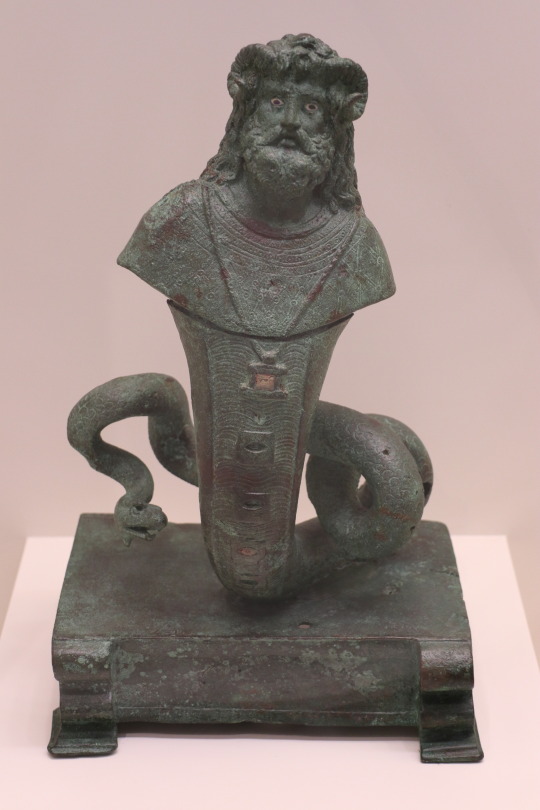
Statuette (copper alloy) of the composite Greco-Egyptian deity Serapis Amun Agathodaimon. Artist unknown; 1st cent. BCE/CE (late Hellenistic or early Imperial). From Egypt; now in the National Archaeological Museum, Athens, Greece. Photo credit: George E. Koronaios.
#classics#tagamemnon#Ancient Greece#Egypt#Ancient Egypt#Greek religion#Ancient Greek religion#Hellenic polytheism#Egyptian religion#Ancient Egyptian religion#kemetic#syncretism#Serapis#Serapis Amun Agathodaimon#Hellenistic period#Ptolemaic#Ptolemaic Egypt#Roman Imperial period#Roman Egypt#art#art history#ancient art#Greek art#Ancient Greek art#Egyptian art#Ancient Egyptian art#Greco-Egyptian art#Ptolemaic art#sculpture#statuette
530 notes
·
View notes
Text
Serapis as a domestic/hearth deity: the power and motivation you get to clean and do housework when you get music you can sing and dance to
5 notes
·
View notes
Text
The Percy Jackson/Kane Chronicles crossover actually did teach me something. I did not really Serapis was a deity until I googled him after reading his short story. And it's fascinating to learn about. So I'm just going to recap everything I learned on wikipedia now.
Serapis was either created or popularized by Emperor Ptolemy I. He was supposed to be a god both the greeks and egyptians would like. He was the guardian of alexandria, and his name apparently came from a combination of osiris and the apis bull. Because of that, he was also Isis's husband eventually, after he took Osiris's place. The fun thing is: most of this info got included in Rick Riordan's short story besides the osiris-apis thing. But it's just really interesting to learn about.
#the kane chronicles#kane chronicles#tkc#percy jackson#pjo#pjo hoo toa#percy jackson and the olympians#percy jackon and the olympians#rick riordan#riordan universe#riordanverse#serapis#greek mythology#egyptian mythology
25 notes
·
View notes
Text
📜ISIS AND SERAPIS: SYNCRETISM IN ANCIENT ROME PT. 1📜
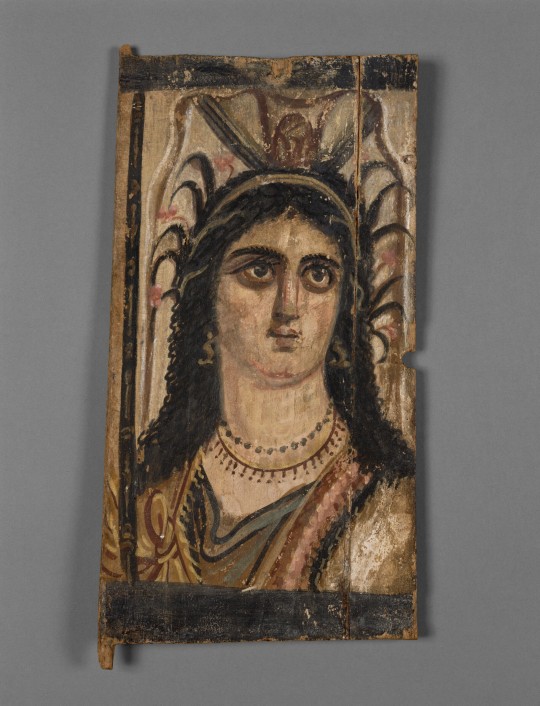

Panels with Painted Images of Isis and Serapis, A.D. 100–200, Getty Villa Museum.
Many gods, mostly of oriental origins, were asimilated by the Ancient Romans once they conquered or made contact with the their territories. Cybele (of Anatolian roots), Mitra (Persian) or Isis and Serapis (Egyptian and Greco-Egyptian, respectively) were figures of devotion in many Ancient Roman houses. Earlier greek syncretism also helped making these relationships closer.
Coins, statues and temples were made in honor of them, and they were respected as equal to the "traditional" Roman deities we usually think of.
The way cults worked, however, was different: some of them had mistery cults associated with their figure, which we´ll discuss in the second part of this post.
Isis and Serapis were firstly associated by the Greeks with Persephone and Hades. Serapis is, in fact, a god formed by the union of Osiris, husband of Isis, and Apis, a bull god son of Isis. The Serapeum of Alexandria was the biggest temple dedicated to this specific deity, but it was sadly destroyed in approximately 391, just when christianity was rising to power.
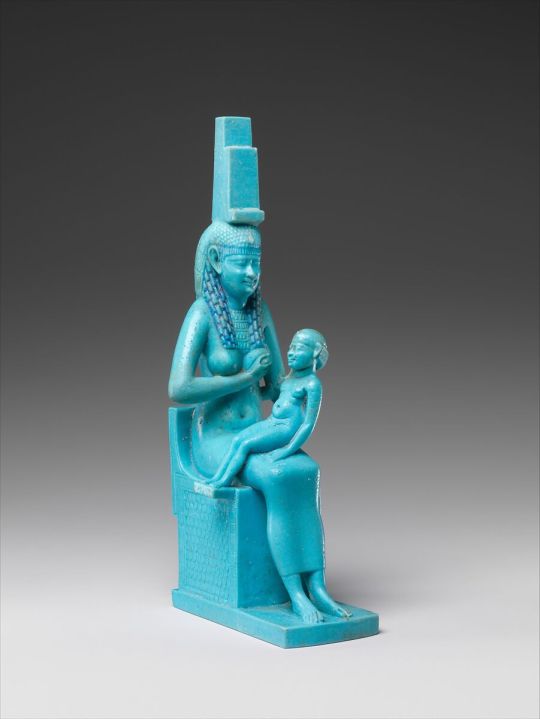
The Goddess Isis and her Son Horus,332–30 B.C(Ptolemaic period),the MET Museum.
#isis goddess#ancient egypt#ancient history#ancient rome#syncretism#serapis#cybele#cibeles#Ancient rome#roman history#pompeii#mitra#hellenic pagan#hellenism#hellenic paganism#hellenic polytheism#art
27 notes
·
View notes
Text

The term "Christ" arose after Serapis Christus was declared the new object of worship by the Vatican after 325 CE. Before that, the term "Christ" was spelled "Chrestos" or "Christos" which is a term the Greeks used for describing Osiris.Osiris was a flesh & blood deity, & he genetically engineered a group of humans to have the SAME "Christ" like abilities he had.What made Osiris a "Christ" being was the fact that he could defy most "laws of physics" simply by activating the kundalini fire through his vertebrae.Your "good book" states "Christ died at the age of 33." Your spinal cord originally contained 33 pieces. After the "Christ" dies at 33, he rises & is REBORN in 5th Density.The story of the death & resurection of "Jesus Christ" is nothing but a depiction of Ausar's kundalini activation in his body, & the kundalini activation in the bodies of every other human."Christ" dies at 33, the kundalini fire stops rising after it hits the 33rd piece of your spine. "Christ" is reborn in a higher realm, & the kundalini fire rises above your spine, hits your pineal gland & allows you to tap into 5th dimensional consciousness.The death & rebirth of "Christ" deals with the kundalini of the spine rising to the pineal gland, & fully activating 5D consciousness. Jacob's Latter is known as a gateway to "heaven." Jacob's latter is nothing but your DNA strands.This is why the "jab" uses metallic A.i. strands to take over your organic DNA strands, because the beast knows your DNA is your "Jacobs latter." If you have no organic DNA, you have NO access to your ancestors, you have no more connection to nature on Earth, no more connection to the cosmos, & no more connection to 5D frequencies.You take that "jab" & you'll allow the A.i. from 5G to stop you from reaching 5D.
17 notes
·
View notes
Text

Marble statue of the Nile God (Statua del dio Nilo) in the Vatican Museum in the Vatican City
Dating back to the 1st or 2nd century AD. Housed in the New Wing of the Vatican Museums, the sculpture was found in 1513 in the Campo Marzio area of Rome. It was probably part of the Iseo Campense, the largest sanctuary dedicated to Isis and Serapis, the Egyptian deities.
16 notes
·
View notes